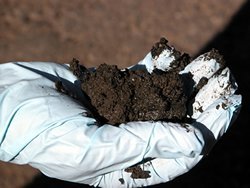
I’ll admit that I have thought about what happens to our waste. We go about our business, flush the toilet, then where does our fecal matter go?! Does it just sit in pipes and sewage systems? But look at how many people there are in this world…if everyone goes just once a day, that’s quite a build-up! Actually, wastewater is treated to create biosolids.
Biosolids are nutrient –rich organic materials that result from the treatment of human waste from sewages. Biosolids can be applied as fertilizer to improve and maintain productive soils and stimulate plant growth. They are used in the forestry industry to promote the growth of trees and used by farmers and gardeners to quicken the growth of agricultural crops, fertilize gardens, and reclaim mining sites. Biosolids can be highly valuable resources, because they are made of natural components suitable for replacing chemical fertilizers. They can be composted and are even sold and distributed to be spread over lawns in some places.
Biosolids are created in the process of treating wastewater and are the residuals when the water is purified to make the water safe to drink, for recreational purposes, and to improve marine water quality for recreation and seafood harvesting. When wastewater reaches the sewage treatment plant, industrial facilities pre-treat the wastewater to remove hazardous contaminants before it is sent to treatment. The sewage goes through physical, chemical and biological processes to separate water from the waste. The solids are treated to the right pH level and odours are eliminated. The process also sanitizes the wastewater to kill disease-causing bacteria, viruses and parasites.
The topic suggests that biosolids are only used as sustainable agricultural fertilizer in other parts of the world, but this practice is actually used in Canada, as well as the United States. Municipalities are required to treat wastewater in Canada. Their options include recycling the biosolids as fertilizer, to incinerate it, or to bury it in a landfill.
In the Ottawa-Carleton region, biosolids are disinfected at the Pickard Centre, where the initial part of the process is to separate water from sludge. The water is brought back to the Ottawa River, while the sludge goes through a process to eliminate moisture and bacteria. A polymer solution is added to the sludge to create biosolids. They are regularly checked for contamination, as there are strict rules on the use of biosolids from the Ministry of Environment. Biosolids are not allowed to be used for home gardening and plants due to regulations. They contain high contents of nitrogen, phosphorus and metals that are good for growing crops. Biosolids are used as fertilizers for hay, corn, pasture, commercial sod, cereal, ornamental crops, and trees. In Quebec City, biosolids are dried into pellets to power the municipal incinerator. Other cities in the country, including Toronto, turn sludge into synthetic crude oil and coal. Burning biosolids create ash that can be used to make concrete and planting soil. Farming communities in Ontario actually ask for biosolids to be used on their land and are pleased with the results.

Some environmentalists have expressed concerns, such as biosolids putting toxins in the soil. Others say that sewage treatment should be researched further before applying it to our lands. However, many health experts support the land application of biosolids. If you really think about it, it kind of makes sense. We use horse and cow manure to plant things, so is human waste that different? The Water Environment Assosication of Ontario compiled a report in 2001 that stated the use of biosolids are safe in Ontario. Citizens have been worried with how biosolids would smell, but it depends on how they have been treated. Some smells are due to their composition of sulphur and ammonia, important nutrients for plants.
Works Cited
Canadian Water and Wastewater Association. (2003-2010). FAQ- Biosolids. Retrieved April 5, 2010, from CWWA: http://www.cwwa.ca/faqbiosolids_e.asp
Mills, D. (2001, February). Is Human Waste Safe as Fertilizer? Retrieved April 5, 2010, from Peace and Environment News: http://www.perc.ca/PEN/2001-02/s-mills2.html
Nierenberg, D. (2007, October 11). Real organic agriculture: Using human waste as fertilizer. Retrieved April 5, 2010, from Worldwatch Institute: http://www.worldwatch.org/node/5394
van der Zee, B. (2008, January 17). Crazy idea, but it just might work. Retrieved April 5, 2010, from guardian.co.uk: http://www.guardian.co.uk/environment/2008/jan/17/waste.renewableenergy